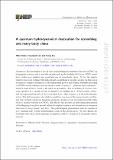A quantum hydrodynamical description for scrambling and many-body chaos
Author(s)
Blake, Michael Andrew; Lee, Hyunseok; Liu, Hong
Download13130_2018_Article_9227.pdf (886.6Kb)
PUBLISHER_CC
Publisher with Creative Commons License
Creative Commons Attribution
Terms of use
Metadata
Show full item recordAbstract
Recent studies of out-of-time ordered thermal correlation functions (OTOC) in holographic systems and in solvable models such as the Sachdev-Ye-Kitaev (SYK) model have yielded new insights into manifestations of many-body chaos. So far the chaotic behavior has been obtained through explicit calculations in specific models. In this paper we propose a unified description of the exponential growth and ballistic butterfly spreading of OTOCs across different systems using a newly formulated “quantum hydrodynamics,” which is valid at finite ℏ and to all orders in derivatives. The scrambling of a generic few-body operator in a chaotic system is described as building up a “hydrodynamic cloud,” and the exponential growth of the cloud arises from a shift symmetry of the hydrodynamic action. The shift symmetry also shields correlation functions of the energy density and flux, and time ordered correlation functions of generic operators from exponential growth, while leads to chaotic behavior in OTOCs. The theory also predicts an interesting phenomenon of the skipping of a pole at special values of complex frequency and momentum in two-point functions of energy density and flux. This pole-skipping phenomenon may be considered as a “smoking gun” for the hydrodynamic origin of the chaotic mode. We also discuss the possibility that such a hydrodynamic description could be a hallmark of maximally chaotic systems. Keywords: Effective Field Theories, Gauge-gravity correspondence, Quantum Dissipative Systems
Date issued
2018-10Department
Massachusetts Institute of Technology. Center for Theoretical Physics; Massachusetts Institute of Technology. Laboratory for Nuclear ScienceJournal
Journal of High Energy Physics
Publisher
Springer Berlin Heidelberg
Citation
Blake, Mike, et al. “A Quantum Hydrodynamical Description for Scrambling and Many-Body Chaos.” Journal of High Energy Physics, vol. 2018, no. 10, Oct. 2018. © 2018 The Authors
Version: Final published version
ISSN
1029-8479